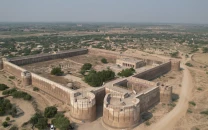Sindh on its toes as Manchar Lake surges
Evacuation of five Jamshoro union councils ordered

The rain-induced devastating floods in the country that have already ravaged Balochistan, Khyber-Pakhtunkhwa and parts of Punjab leaving millions homeless and over 1,250 people dead in their wake continue to wreak havoc in Sindh.
The situation at Manchar Lake, the largest natural freshwater lake in Pakistan, is becoming critical with each passing day, threatening the lives and assets of the residents of five union councils of Jamshoro district.
The Sehwan Airport, an installation of an oil company as well as Sindh Chief Minister Murad Ali Shah’s home village, are located in the five UCs – Bubak, Aarazi, Wahar, Jaffarabad and Channa.
Jamshoro Deputy Commissioner Capt (retd) Fariduddin Mustafa on Saturday issued evacuation orders for the people of the five UCs, saying that they should move out to safer places.
The water level at the lake further increased to 123 Reduced Level (RL) amid strong winds.
During his recent visit to Manchhar Lake, the Sindh chief minister said that the water level in the lake would be dangerous if it reached to 123 feet, which at that time was 120.75 feet.
The lake’s gushing water flooded two rural towns – Jhangara and Bajara – and surrounding villages on Saturday.
The villages and towns are particularly endangered by the rising water pressure on the lake’s embankments after deluging Jhangara and Bajara towns.
“The next 24 hours will be very critical,” the DC said. “We are keeping a watch on the banks day and night.”
The road links of many small towns and villages with Sehwan are already under water. The lake is receiving around 40,000 cusecs water from Main Nara Valley (MNV) drain and the hill torrents. However, only around 25,000 cusecs is being released in the Indus River and 15,000 cusecs retained in the lake.
However, Sindh Irrigation Minister Jam Khan Shoro gave a ray of hope provided that the lake’s embankments sustained the bulging water pressure for a couple of days more.
“In order to save Manchar Lake and the surrounding areas, we have decided to stop the discharge of Indus River water at Guddu and Sukkur barrages,” he told the media.
The river cannot take much water from the lake’s two outlets near Sehwan because it is flooded, but if the water level in the river reduces, more water from the lake can be released into the river.
The minister said additional benefit of reducing the river flow at the two barrages would result in draining the water from rain-flooded areas of Khairpur and Naushehro Feroze districts.
“We will release the flash floods from Khairpur and Naushehro in Indus from Kandiaro escape,” he added.
The flood level increased to 559,989 cusecs at Sukkur Barrage on Saturday but lowered to 532,634 cusecs at Guddu Barrage.
That at Kotri Barrage, which is the last one before the Arabian Sea, was recorded at 575,141 cusecs.
Separately, the water from Balochistan’s mountains flooded Gaji Khuhawar, a rural town in Larkana, on Saturday. The water entered the town after rupturing the ring embankment, which was erected by the local people, and entered the houses, shops, health facilities and government offices.
The water flowing from Suprio bund’s breach and overtopping the Indus Highway flooded Gaji Khuhawar.
KN Shah floods
The residents of flooded Khairpur Nathan Shah taluka of Dadu district have blamed the government for leaving them high and dry by not providing them ration, tents and other necessary things for their livestock’s survival.
At a protest in Dadu, they appealed to the chief justice of Pakistan to take notice as to why their taluka was always deluged by heavy rain and floods, putting the onus of their miseries on the government.
They claimed that 70% of the town’s population, estimated around 250,000, had moved out but 30% people were staying behind to protect their homes, properties and assets.
Those people need ration, water and tents for survival.
Also read: Khairpur Nathan Shah goes under water
Meanwhile, the people of Mehar taluka of Dadu spent another day trying to reinforce the bund.
Women and children worked shoulder to shoulder with their men to save their town.
“We have to save Mehar because nothing else is left,” an elderly woman said, referring to all the submerged villages on Mehar’s outskirts.
The residents of those villages have taken refuge mostly on the roads and pieces of unoccupied lands in Mehar. Floodwater has reportedly surrounded 30-kilometre radius of the area.
In the left bank districts of the Indus River, rainwater spilling from the breaches and overtopping Puran Dhoro, Hakro Dhoro and Left Bank Outfall Drain kept the towns and hundreds of villages in Mirpurkhas and Badin under water.
57 more killed
The toll from cataclysmic floods continued to climb on Saturday with 57 more deaths, 25 of them children, as the country grappled with a relief and rescue operation of near unprecedented scale.
A high-level body set up to coordinate the relief effort met in Islamabad with Prime Minister Shehbaz Sharif in the chair to take stock of the disaster.
Record monsoon rains and melting glaciers in northern mountains brought floods that have affected 33 million people and killed at least 1,265 people, including 441 children.
The inundation, blamed on climate change, is still spreading.
The proportion of children's deaths has raised concern.
On Friday, the United Nations children's agency said there was a risk of "many more" child deaths from disease after floods.
The floods that have inundated a third of the country were preceded by four heatwaves and multiple raging forest fires, the disaster management chief told the high-level meeting, highlighting the effects of climate change in the South Asian nation.
"The year 2022 brought some harsh realities of climate change for Pakistan," National Disaster Management Authority chief Lieutenant-General Akhtar Nawaz told a briefing for the country's top leadership.
"This year we did not witness a spring season - we faced four heatwaves which caused large-scale forest fires across the country," he said.
The fires were particularly severe in Balochistan, destroying swathes of pine-nut forests and other vegetation, not far from areas now underwater.
Balochistan has received 436% more rain than the 30-year average this monsoon. The province has seen widespread devastation, including a washing away of key rail and road networks as well as breakdowns in telecommunications and power infrastructure, the meeting was told.
The country received nearly 190% more rain than the 30-year average in the quarter through August, totaling 390.7 millimetres (15.38 inches).
Sindh was hardest hit, getting 464% more rain than the 30-year average. Aid has flowed in from a number of countries, with the first humanitarian assistance flight from France landing on Saturday morning in Islamabad.
But the largest charity group said there were still millions who had not been reached by aid and relief efforts. Initial estimates of the damage have been put at $10 billion, but surveys are still being conducted along with international organisations.
The United Nations has appealed for $160 million in aid to help tackle what it said was an "unprecedented climate catastrophe" as Pakistan's navy fanned out inland to carry out relief operations in areas that resemble a sea. (With input from Reuters)



















COMMENTS
Comments are moderated and generally will be posted if they are on-topic and not abusive.
For more information, please see our Comments FAQ